Recently, the euonymus (Euonymus) has become very popular among the owners of country houses – an ornamental plant that perfectly copes with the task of landscape gardening.
There are several legends about this shrub from the Bereskletovye family. According to one of them, it was created by an evil sorceress who, in her anger at people, decided to grow a poisonous plant in order to take revenge on humanity, but in the process changed her mind and endowed it with medicinal properties.
The sorceress herself turned into a small robin and became the only bird not afraid of the poison of the plant. Another legend tells about the goddess Flora, who created a bush from a lost earring and a brooch: in the place where she lost them, an euonymus grew, blooming with earrings. If there is a support, it will crawl along it, but it is mainly a creeping plant. The crown can be given any shape, which makes the plant an ornament to any corner.
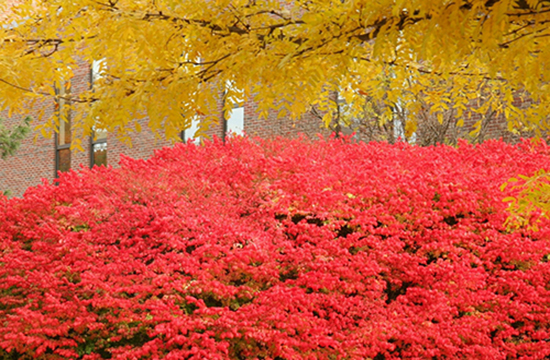
Euonymus as an indoor evergreen plant attracts special attention of gardeners with the unusual color of autumn leaves and bright earrings with inedible seeds.
Motherland – Southwest Asia. Evergreen ornamental shrub, grows up to 1-1.5 m indoors. Distributed in Australia, America. The shrub was brought to European countries from China. There it was first discovered and described by the English biologist Robert Fortune. The name, translated from Latin, means “alluring beauty.” The Slavs called this plant in different ways: night blindness, bruslina, mesklet, wolf earrings, God’s eyes.
What the euonymus looks like and how it blooms: photos of leaves, flowers and fruits
Fortune’s spindle tree looks like a low shrub, deciduous or evergreen – a variety of varieties gives a wide range of properties. Depending on the species, it grows as a shrub or tree, the height can be different – in nature there are specimens up to 8 m tall. Among the cultivated there are dwarf and even creepers.
The shape of the plant is created by rounded shoots – upright, creeping or branched, depending on the variety.
When describing the decorative spindle tree, the leaves of the plant are especially remarkable: smooth, leathery, with greenish-white flowers. Their surface is shiny, dark green, sometimes with spots of white, cream color. Autumn gives them different shades of red. The leaves are placed very tightly, creating a continuous openwork crown. Small in size, oblong, slightly elongated, grow on short cuttings. Quite often they have two colors: in summer, bright green leaves are cast in gold or silver, in autumn they give them red, white, orange and yellow colors.
This photo shows the leaves of the creeping euonymus – their color is bright and very original.
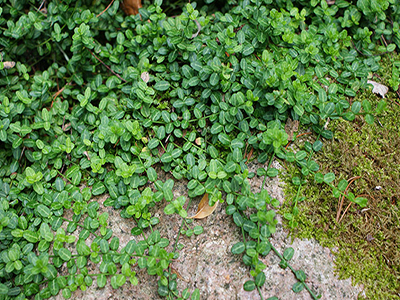
On the branches of the euonymus, small nodules are formed that release roots – thanks to them, the plant crawls along the ground or braids the meeting supports. They contribute to the growth in breadth: if you press the knot to the ground, it will put the root into it.
As for how the shrub blooms: it is difficult to call euonymus flowers beautiful. There are not very rare, inconspicuous-looking flowers in the form of earrings of a pale green color, with an unpleasant odor. Collected in inflorescences of 4-5 pieces, racemose or thyroid in shape. They are not a decorative merit of a plant, unlike fruits. They are not used in medicine, unlike the whole shrub, and are not of particular decorative value. Flowering unattractive euonymus occurs in May-June.
All parts of the plant are poisonous, so many do not risk planting it at home: 35 berries are a lethal dose for an adult. A smaller dose can lead to paralysis, weakness, diarrhea, arrhythmia, which is very important to consider when planting a site: in places where children play, it is not planted.
Of particular interest are the fruits of the decorative euonymus: a four-part box of an unusual shape. A ripe box changes its usual green color to bright red, yellow, white and pink colors, and after cracking it becomes like an open parachute: the seeds hang on thin threads.
In room conditions, only two species are grown – Forchun’s euonymus (E. fortunei) and Japanese euonymus and its varieties or varieties.

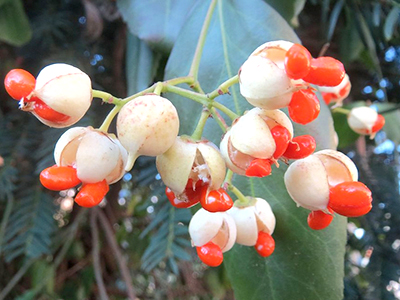
Types and varieties of garden euonymus: photos, names and descriptions of varieties
Today there are about 220 varieties of decorative euonymus, a brief description of some of them is given below.
European spindle tree (Euonymus europaea) : grows in Western Europe, Asia. It has the shape of a tree, bushes, its height can reach 6-8 m. Young shoots are green, as the tree grows older, they become almost black in color, cork growths characteristic of the plant grow on them. The length of the leaves reaches 11 cm, have an oblong shape. Flowers are collected in 4-5 pieces. in inflorescences, have a greenish-white color. The plant is very hardy. It has many species, and the popular varieties of the European euonymus are:
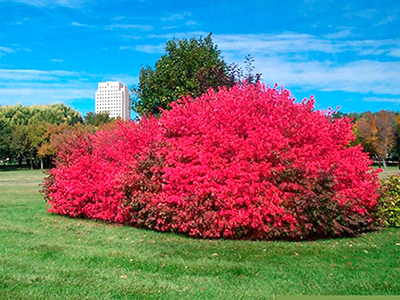
Red Cascade Albus.
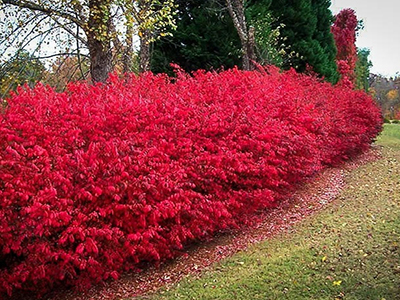
A distinctive feature of the first grade is the rapid loss of seed germination: in order for them to germinate, they must be stratified before planting. The second variety blooms with cream flowers, and the seeds acquire an orange color.
Euonymus fortunei (Euonymus fortunei) is considered a very common species. This is a creeping shrub, its height is 30-60 cm, sometimes up to 1 m. This is a very decorative form that adorns any area. Can easily and quickly cover large areas of land. Oblong leaves about 4 cm long, bright green saturated color, on the leaves of some varieties of this species – white and golden spots and a border. This species is native to China. It grows well in the shade, besides it is frost-resistant.
Photos of popular varieties of this type of euonymus can be found here:
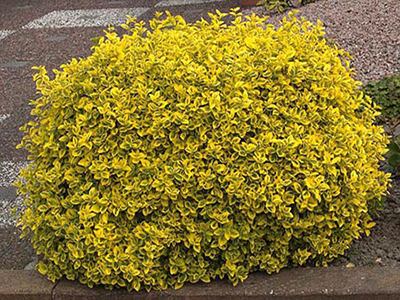
This is Emerald Gaiety (Emeraldn Gold) which is easy to grow in tubs or pots and spreads well.
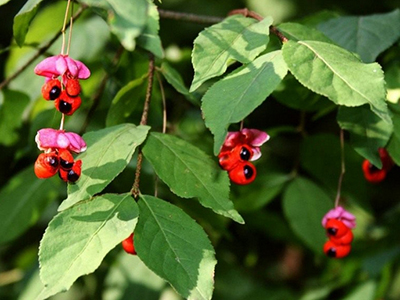
Radicans is the most valuable variety of the species. In addition to the ability to creep, he has another feature – he can climb walls or trees. The variety belongs to evergreens.
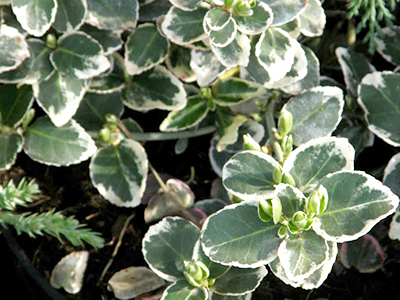
Warty euonymus (Euonymus verrucosa) : grows in the European part of Russia, in the mountains of Central Europe, South, South-East. Shrub up to 2 m high or tree 5-6 m. The shoots are bright green, the branches are strewn with black warts (hence the name of the plant). The leaves are light green, the flowers are slightly brown, the fruits are pink, the seedlings are red-brown. It looks especially beautiful in autumn. It grows slowly, but is unpretentious and tolerates shade well, which allows garden decorators to often use this variety in their work.

Winged euonymus (Euonymus alata) : its homeland was the Far East, Korea, Sakhalin. The shrub is low, in nature it grows up to a maximum of 2 m, in cultural conditions – no higher than 1 m. The leaves are diamond-shaped, green, in autumn they turn red. The branches of the shrub are especially beautiful – rounded tetrahedral, with small growths.
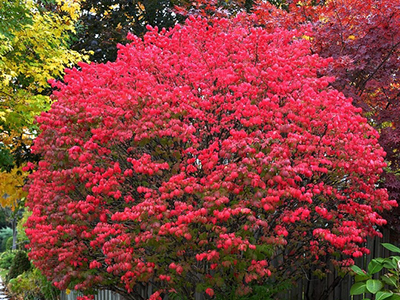
“Emerald Gold” Such a description characterizes the shrub very much: medium-sized leaves are oblong in shape, have an original color – the plate in the center is bright green, and is framed in golden along the edges. In autumn, the edge changes color – in the palette from pink to deep red. It tolerates winter temperatures well. Among the popular varieties is Compactus, a stunted shrub no more than 1 m in height, growing wonderfully in the shade.
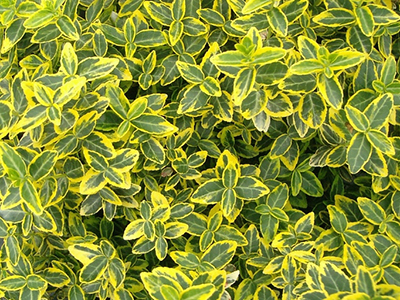
Of great decorative value is the dwarf euonymus, with a creeping form: in the absence of a trunk, the branches are densely covered with closely adjacent one to one leaves. Below are photos of several types of dwarf euonymus with names placed next to them, which are worth considering in more detail.
“Emerald gaiety” : a low plant 20-30 cm, with short branches, spreads weakly. The leaves are ovate, elongated, light green in color with a white border around the edges. Frost-resistant.
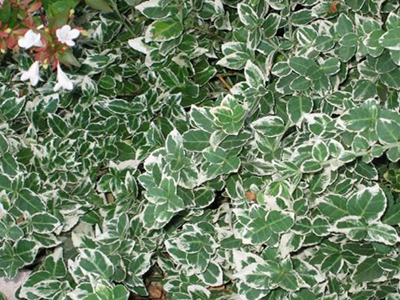
Baby ( “Minimus” ): one of the varieties of dwarf euonymus, and in the proposed photo you can see a creeping plant no higher than 5 cm, resembling a pillow in density. Oblong leaves of intense green color with white veins. Perfectly performs the function of a cover plant, used in the design of garden borders.

“Vegetus” : very fast growing shrubs, most similar in appearance to wild ones, capable of covering large surfaces with a lush carpet in a very short time. Height 15-20 cm. Leaves up to 40 mm, ovate, white veins, matte surface.
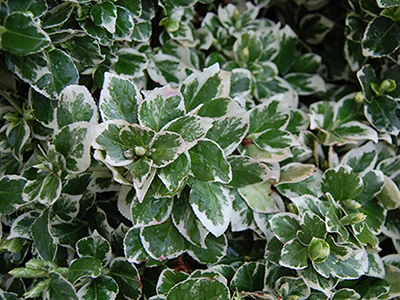
Indoor view of the euonymus flower: photo and description of the plant at the time of flowering
Japanese euonymus ( E.japonisa ): this is the only species of all euonymus, which is grown as an indoor and as a garden bush. In the wild, the bush can grow to a height of up to 7 m. Branches extend from the trunk at a slight angle, rushing up. The leaves are large, leathery, very dense, green, uneven at the edges, with a light border. A characteristic feature is that its growth is possible only under certain conditions, in their absence, it will first begin to grow in the spring, but then it will stop and freeze. In the case of having everything necessary for growth in a year, it can add 15-20 cm. The following are photos of Japanese spindle tree varieties and a small description of them.
Japanese euonymus “Aureovariegata” ( “Aureovariegata” ) – leaves with a graceful golden border.

Japanese euonymus “Mediopicta” ( “Mediopicta” ) – leaves with green edges and a golden core.
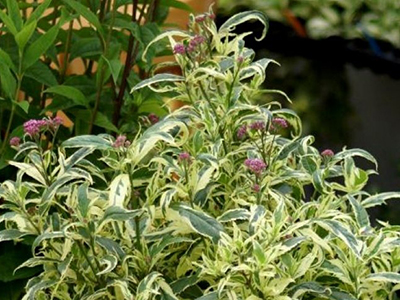
Latifolius Albomarginatus – intense green leaves with a wide white rim around the edges.
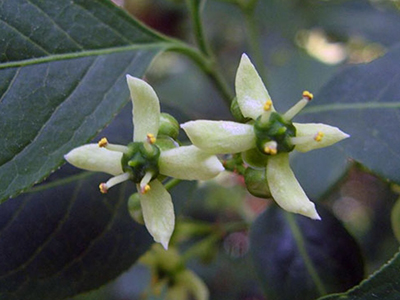
Pyramidata – a bush having the shape of a pyramid, the leaves are elliptical wide.
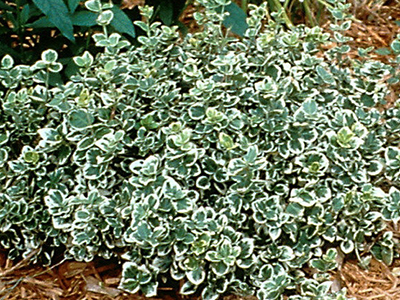
Microphyllus – a variety with variegated leaves, up to half a meter high, a bush diameter of about 15 cm, leaves are raised, yellow-green in color, flowers are white.
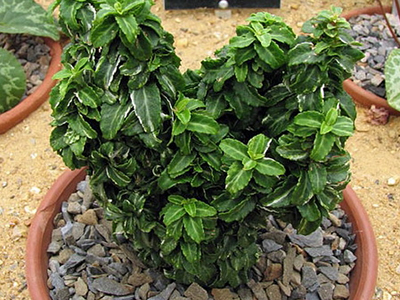
Growing a Japanese euonymus and the rules for caring for it are practically no different from the usual care of indoor flowers in winter or garden flowers in spring and summer. It is better to grow in large pots or boxes, in winter it should be brought into a room with a rather cool climate, where it will wait for spring – temperatures below 5 ° are poorly tolerated by the plant.
As an indoor home flower, the euonymus is used as a pot culture.
How to properly care for euonymus and growing conditions
requirements for environmental conditions. Euonymus prefers bright diffused light, but also tolerates partial shade. Variegated forms are photophilous. In summer, the plant can be taken out into the air. The temperature in summer should be 20° for the plant to feel comfortable. It can withstand a short rise in temperature, but this is fraught with an attack of ticks for it. In winter, the temperature in the premises should be in the range of 8-10 °C.
Potted plants growing in greenhouses can overwinter at a temperature of 8-16 °. And how to properly care for the euonymus in the hot season? In such seasons, spraying is recommended.
When growing a bushy spindle tree, one of the conditions for good growth is the required level of soil moisture. Therefore, watering is moderate. Reduce watering in winter. Drying out of the soil coma is unacceptable, it is detrimental to the plant. In this regard, the level of humidity should be strictly controlled. Watering is especially important for young plants: in order for them to take root faster, they need to be watered 7-10 times during the day. In dry summers, do this more often. Experienced gardeners give advice: the near-stem circle of the plant can be mulched, so it will be easier for him to cope if the earth dries up.
Euonymus formation and bush pruning
When growing euonymus, it is important to form its crown as part of landscape decorations. This will help timely haircut and shaping. In the spring, it is necessary to remove broken and dried branches, carefully cut out the shoots that grow inside the form. In summer, the crown should be trimmed, while giving it the desired lines. By repeated pruning, you can create a crown of the most bizarre shape. In the spring, you should pinch the shoots. The plant responds to shearing with rapid branching.
Formative pruning of rapidly growing euonymus is carried out, as a rule, in spring or after fruit ripening. During the growing season, partial thinning can be carried out for sanitary purposes, removing weak shoots. The cutting shape can be conical or ellipsoidal.
Planting and transplanting euonymus at home and in the garden
When the plant is grown outdoors, it can take a long time, and tub bushes or trees require regular repotting. This process takes place in the spring, the plant rolls over into a large pot. If there is no transplant of the grown euonymus, the bush will stop its development.
Care during the growing season: after cracking the box, you must immediately collect the seeds, remove the seeds, treat with a solution of potassium permanganate, plant in the soil, which is pre-moistened. Cover crops with straw or dry fallen leaves.
In winter, the cultivation of decorative euonymus, as well as caring for it, requires a special approach. Despite the frost resistance of the shrub, young seedlings need shelter. You can ensure proper wintering in the following way. Young, up to 3 years old, plants must be covered with dry foliage or spruce branches. An adult shrub will be able to winter in the garden without it, but to prevent freezing of the roots, it will be right to mulch the near-trunk circle with leaves or sawdust.
The plant needs constant feeding – mineral and organic fertilizers are suitable for this. During the growing season, top dressing is carried out with a complete mineral fertilizer once a month. In autumn, top dressing is done with fertilizers with a high content of phosphorus, potassium.
It is quite easy to plant a decorative home-grown euonymus and take care of it if you follow the rules. This is best done in autumn or spring. The seat should be loose and carefully dug up.
Pot specimens are transplanted annually, tubs – after 2-3 years. The substrate should be prepared from soddy, leafy soil, humus and sand (1: 1: 2: 1).
How to properly propagate euonymus
How to propagate home euonymus? To do this, you can use seeds, layering, dividing the bush, cuttings. When propagated by layering, the shoots of the mother plant, which grow very low to the ground, are bent down, carefully placed in a groove in the soil, fixed, sprinkled with soil. The top of the shoot remains on the surface. When the layering takes root, it can be transplanted to a permanent place.
If the euonymus is propagated through propagation by young cuttings, then they must be cut from the tops of half-woody shoots of those plants that are at least 5 years old. The length of the cuttings should be about 7 cm, and they should have at least one internode, they are collected around June. The cut is treated with a root former, placed in peat mixed with sand. Keep under the film, the place should be bright and cool. One and a half to two months – and rooted cuttings can be planted already in the ground in the open air and grow. Euonymus cuttings are propagated in spring and summer.
Some plants with such cuttings are placed in containers with a small amount of water, but since the euonymus, when propagated by its cuttings, cannot stay in the water for too long, the peat in which they are placed is abundantly saturated with water.
Why do euonymus leaves fall, diseases and pests of the bush
The main pests of bushy euonymus are mealybug, caterpillars, aphids, spider mites. Ticks and aphids feed on plant sap and leave tiny silvery punctures on the leaves, which leads to deformation of the leaves and growing shoots. You can fight them by treating the plant with Aktellik’s solution three times every week. Mealybugs create deposits that look like cotton cocoons and honeydew on leaves. Processed in two stages with Confidor, Fitoverm, taking a break of 7-10 days. Caterpillars can only be destroyed by manually removing their nests.
Diseases of decorative euonymus include powdery mildew or stem rot. The latter is a very serious disease. Which is difficult to treat, therefore it is easier to carry out prevention in the spring and autumn, treating the plant with a Bordeaux mixture (1%) or similar preparations. Affected areas must be removed and burned, because. fungal disease. Powdery mildew can only be fought with fungicides Fundazol, Skor, Previkur, for 3-4 sessions, maintaining an interval of 7 days.
If the spindle leaves suddenly fall or turn yellow, the reason usually lies in excessive watering – it needs to be adjusted.
Despite the poisonousness of the euonymus, traditional medicine often uses it. Fruits, leaves, wood are used – due to the content of organic acids, tannins, pectin, sucrose, carbohydrates and many other substances in them. The use of decoctions and infusions will have the following effects: antiviral, antiemetic, laxative, antispasmodic, choleretic, and even help get rid of parasites. However, you should be careful: an overdose will lead to inflammation of the intestines, a slowing of the pulse, and may cause vomiting. Contraindicated in pregnant women, people with heart failure. In any case, before use, you should consult your doctor.
Euonymus feels good even in polluted air. That allows you to use it when decorating park areas, as well as when decorating squares. High types of plants are used to create hedges, alpine slides. Examples of how you can apply euonymus in landscape design are shown in the video. The plant elegantly decorates flower beds, garden paths, borders, is used to decorate outbuildings, hedges. Euonymus can be single planted on the site. Creeping species or dwarf plants are used as ground covers or creepers. Dwarf bushes can also be planted in pots and neatly arranged around the area.







